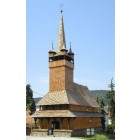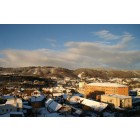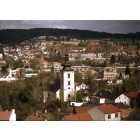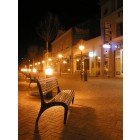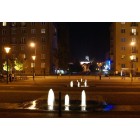Blansko lies in the north of the South Moravian Region in the valley of the River Svitava on the boundary between the Drahany Highlands and the Highlands of Bohemia and Moravia around 30 km north of Brno. The region is blessed with areas of natural beauty, a rich history and important architectural monuments. Blansko itself is often referred to as the “Gateway to the Moravian Karst”. The Moravian Karst was declared a protected landscape area in 1956. The town currently has a population of around 20,000.
Blansko is rightly known as a town of sport and culture. There are a number of sports clubs in the town and excellent facilities for all kinds of sport for amateurs and professionals alike. The recreation area on the Palava reservoir serves the local population, offering minigolf, a sandy beach and a children’s playground, an ice-skating rink which changes into an artificial in-line skating centre in the summer months, an indoor swimming pool and an outdoor pool, a sauna, tennis and volleyball courts, a squash centre, a bowling hall, a skittle alley and a new baseball ground.
Those looking for culture will also find what they are after in Blansko. A number of interesting cultural and social events are held here during the course of the year. The town’s traditional events include a Historical Beer Fair, Witch Burning, a series of concerts known as Music at Blansko Chateau, the Illumination of the Christmas Tree, and New Year in the Town Square. The most important event in the town is, however, November’s Welcoming of Saint Martin which features a number of concerts, exhibitions and a period fair with Saint Martin’s wine, in addition to the ceremonial arrival of the town’s patron on a white horse at the head of a large and varied cortege. The doors of Blansko Town Gallery, which offers excellent presentations of distinguished artists throughout the year, are also open to you. In view of its vicinity to the Moravian Karst, which makes Blansko an attractive destination for tourists, the town also offers an excellent tourism services infrastructure.
Blansko Chateau
The Renaissance chateau stands on the site of an original Gothic feudal court mentioned in sources from the fourteenth century. The building has four wings with a rectangular inner courtyard with pillared arcades. The chateau’s Renaissance appearance dates back to the beginning of the seventeenth century. It was built in 1604–1605 by Jan Žalkovský of Žalkovice. It has undergone numerous alterations since that time. In 1695, the Gellhorns built the chateau tower and clock, while the interior layout was altered during the time of the Salms in the nineteenth century. General repairs to the chateau were performed in 1969 with the aim of restoring the purity of the building’s Renaissance style. A number of famous people have stayed here, including doctor and archaeologist Jindřich Wankel, writer Ferdinand von Saar and Caroline Meineke. The chateau is now home to Blansko Museum and permanent exhibitions on regional topics. It also has a number of unusual exhibition halls.
The Wooden Church
The church building comes from Nyzhni Selyschtsche in Sub-Carpathian Ukraine. It was originally intended to be an exhibit at the Exhibition of Contemporary Culture in Brno in 1928. It is one of six churches from Sub-Carpathian Ukraine that were bought by various organisations and sponsors in the years 1929–1936 and taken to various places in the Czech Republic. Its construction began in 1601, but was not completed until 1640. It was consecrated to the Orthodox Saint Paraskeva. It now serves the Czechoslovak Hussite Church and the Evangelical Church of the Czech Brethren.
Saint Martin’s Church
A Baroque structure built in 1672–1691. A Romanesque (and later Gothic) church originally stood here, established in the first half of the twelfth century by Bishop of Olomouc Jindřich Zdík. The ancient bell Poledník (Meridian) in the church tower is one of the oldest in Moravia. In 1707–1708, the church was restored and a new tower, an oratorio and a choir built. The church was again restored and enlarged in 1889. A monument to Karoline Meineke, the first wife of King of England William IV can be found in the immediate vicinity of Saint Martin’s Church. A rosarium was planted near the church in 2008 and a lookout point in the church tower opened to the public in 2012.
The administration building of the company Ježek
The building dates back to 1910–1911. This architecturally interesting structure in the “Windsor style”, inspired by Miramare Castle near Trieste, Italy, was built by the founder of the company K. & R. Ježek. The Ježek railway bridge, an important technical monument, can be found near the building.
www.blansko.cz
Blansko is rightly known as a town of sport and culture. There are a number of sports clubs in the town and excellent facilities for all kinds of sport for amateurs and professionals alike. The recreation area on the Palava reservoir serves the local population, offering minigolf, a sandy beach and a children’s playground, an ice-skating rink which changes into an artificial in-line skating centre in the summer months, an indoor swimming pool and an outdoor pool, a sauna, tennis and volleyball courts, a squash centre, a bowling hall, a skittle alley and a new baseball ground.
Those looking for culture will also find what they are after in Blansko. A number of interesting cultural and social events are held here during the course of the year. The town’s traditional events include a Historical Beer Fair, Witch Burning, a series of concerts known as Music at Blansko Chateau, the Illumination of the Christmas Tree, and New Year in the Town Square. The most important event in the town is, however, November’s Welcoming of Saint Martin which features a number of concerts, exhibitions and a period fair with Saint Martin’s wine, in addition to the ceremonial arrival of the town’s patron on a white horse at the head of a large and varied cortege. The doors of Blansko Town Gallery, which offers excellent presentations of distinguished artists throughout the year, are also open to you. In view of its vicinity to the Moravian Karst, which makes Blansko an attractive destination for tourists, the town also offers an excellent tourism services infrastructure.
Blansko Chateau
The Renaissance chateau stands on the site of an original Gothic feudal court mentioned in sources from the fourteenth century. The building has four wings with a rectangular inner courtyard with pillared arcades. The chateau’s Renaissance appearance dates back to the beginning of the seventeenth century. It was built in 1604–1605 by Jan Žalkovský of Žalkovice. It has undergone numerous alterations since that time. In 1695, the Gellhorns built the chateau tower and clock, while the interior layout was altered during the time of the Salms in the nineteenth century. General repairs to the chateau were performed in 1969 with the aim of restoring the purity of the building’s Renaissance style. A number of famous people have stayed here, including doctor and archaeologist Jindřich Wankel, writer Ferdinand von Saar and Caroline Meineke. The chateau is now home to Blansko Museum and permanent exhibitions on regional topics. It also has a number of unusual exhibition halls.
The Wooden Church
The church building comes from Nyzhni Selyschtsche in Sub-Carpathian Ukraine. It was originally intended to be an exhibit at the Exhibition of Contemporary Culture in Brno in 1928. It is one of six churches from Sub-Carpathian Ukraine that were bought by various organisations and sponsors in the years 1929–1936 and taken to various places in the Czech Republic. Its construction began in 1601, but was not completed until 1640. It was consecrated to the Orthodox Saint Paraskeva. It now serves the Czechoslovak Hussite Church and the Evangelical Church of the Czech Brethren.
Saint Martin’s Church
A Baroque structure built in 1672–1691. A Romanesque (and later Gothic) church originally stood here, established in the first half of the twelfth century by Bishop of Olomouc Jindřich Zdík. The ancient bell Poledník (Meridian) in the church tower is one of the oldest in Moravia. In 1707–1708, the church was restored and a new tower, an oratorio and a choir built. The church was again restored and enlarged in 1889. A monument to Karoline Meineke, the first wife of King of England William IV can be found in the immediate vicinity of Saint Martin’s Church. A rosarium was planted near the church in 2008 and a lookout point in the church tower opened to the public in 2012.
The administration building of the company Ježek
The building dates back to 1910–1911. This architecturally interesting structure in the “Windsor style”, inspired by Miramare Castle near Trieste, Italy, was built by the founder of the company K. & R. Ježek. The Ježek railway bridge, an important technical monument, can be found near the building.
www.blansko.cz


